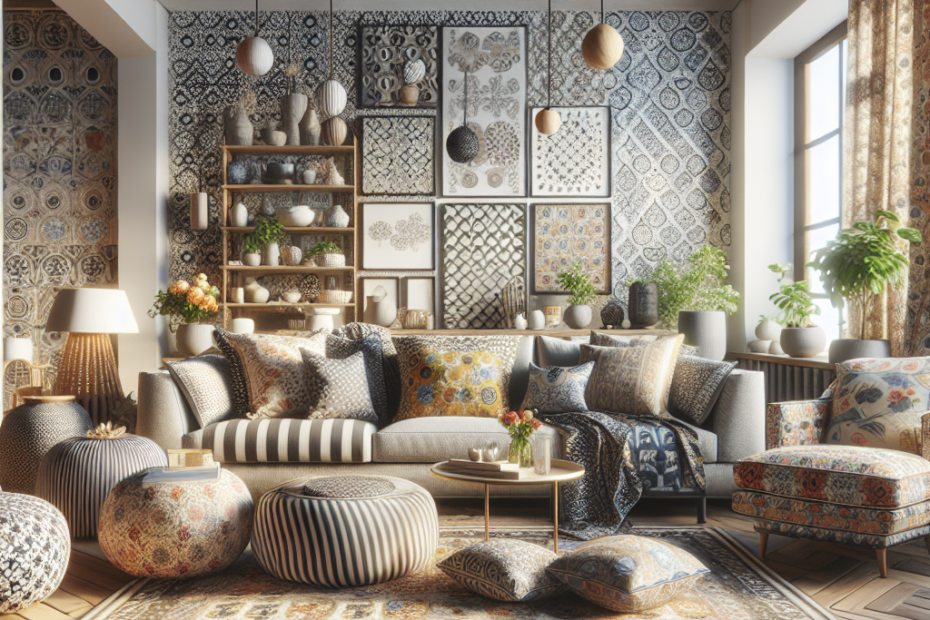Mixing patterns in home decor can be a daunting task, especially for those who are new to interior design. Patterns bring energy, depth, and interest to a room. Whether it’s a living room, bedroom, or even a kitchen, the right combination of patterns can elevate the overall appearance of the space. In this article, we’ll explore some useful tips for mixing patterns in design to create a harmonious and visually appealing environment.
Understanding the Basics of Mixing Patterns
Before diving into pattern mixing, it’s essential to understand the basics. Patterns come in a variety of styles, such as florals, stripes, geometrics, and abstracts. According to a study by the National Design Academy, 70% of professionally designed rooms incorporate multiple patterns to achieve a sophisticated look.
Start with a Color Palette
The first step in mixing patterns is choosing a cohesive color palette. This ensures that even the most diverse patterns appear united. They recommend starting with 2-3 base colors and integrating different shades and tones of these colors within the patterns. This creates a consistent theme throughout the room.
Vary the Scale of Patterns
Different pattern scales add dimension and complexity to a room. Mixing large, bold prints with smaller, more intricate designs can create a balanced look. The scale is a crucial element because it provides visual hierarchy and avoids overwhelming the senses. Interior design experts often suggest using one large pattern, one medium, and one small.
Balance & Symmetry
Proper balance and symmetry are critical when incorporating multiple patterns. Ensure that patterns are distributed evenly throughout the room to avoid concentrating visual weight in one area. For instance, if there’s a large patterned rug, complementary smaller patterns can be added through pillows or artwork.
Combining Different Pattern Types
Combining different types of patterns can add excitement and character to your home decor. Here are some classic combinations that work well together.
Florals and Stripes
Florals and stripes are a timeless combination. The organic shapes of floral patterns contrast beautifully with the linearity of stripes, creating a balanced and cohesive look. This pairing is perfect for both traditional and contemporary interiors.
Geometrics and Abstracts
Geometric patterns and abstract designs can create a modern and sophisticated environment. The sharp, clean lines of geometric patterns complement the fluid and unconventional shapes found in abstract patterns. This combination is versatile and can be adapted for various design styles.
Animal Prints and Solids
Animal prints bring a touch of exotic flair to any space. When mixed with solid colors, they can make a bold statement without overwhelming the room. The key is to keep animal prints in balance with neutral or monochromatic solids to maintain elegance.
| Pattern Type | Popular Use | Complementary Patterns |
|---|---|---|
| Florals | Living Room, Bedroom | Stripes, Solids |
| Stripes | All Rooms | Florals, Geometrics |
| Geometric | Office, Modern Spaces | Abstracts, Solids |
| Animal Prints | Accent Items | Solids, Florals |
Consider Texture and Material
Patterns aren’t limited to prints and colors; they also include textures and materials. Mixing different textures, such as velvet with linen, or wood with metal, can add another layer of interest to the room. According to a survey by Houzz, 55% of homeowners found that combining textures enhanced the overall aesthetic of their interior spaces.
Textures provide tactile and visual variety, making the decor more engaging. For example, introducing a textured throw pillow on a patterned sofa can improve comfort and visual appeal.
Practical Tips for Beginners
For those new to mixing patterns in design, starting small can be beneficial. Here are some practical tips:
- Start with Accents: Begin by introducing patterns through small accents, such as throw pillows, blankets, or rugs.
- Create a Mood Board: Gather samples of your chosen patterns and create a mood board. This helps visualize how they’ll look together before fully committing.
- Trust Your Instincts: While there are guidelines for mixing patterns, personal preference plays a significant role. Trust your instincts and create a space that feels right to you.
- Use Neutrals as Buffers: Incorporate neutral colors to buffer between different patterns, creating a more cohesive look.
- Limit the Number of Patterns: Stick to 3-4 patterns to keep the space from feeling cluttered.
Key Takeaways
- Choosing a cohesive color palette is crucial when mixing patterns.
- Varying the scale of patterns adds dimension to a room.
- Different pattern types, such as florals and stripes, can create harmony and interest.
- Textures and materials also play a significant role in pattern mixing.
- Starting with small accent pieces can make the process more manageable for beginners.
FAQs about Mixing Patterns in Home Decor
- Can I mix patterns in a small room?
Yes, you can mix patterns in a small room. Stick to a limited color palette and vary the scale of patterns to avoid making the room feel cluttered. - What if I’m scared to mix too many patterns?
Start with small accents like throw pillows or rugs. Gradually add more patterns as you become more comfortable. - Can different patterns clash?
Patterns can clash if they are not balanced in color, scale, and distribution. Ensure cohesive colors and varying scales to maintain harmony. - Is it expensive to mix patterns?
No, mixing patterns doesn’t have to be expensive. Start with budget-friendly items, such as pillows, throws, or inexpensive rugs. - What are the best neutral colors to use?
The best neutral colors include whites, grays, beiges, and taupes. These colors act as buffers and help create a balanced look.
By following these tips, they can confidently mix patterns in design and create a visually appealing space that reflects their personal style.
